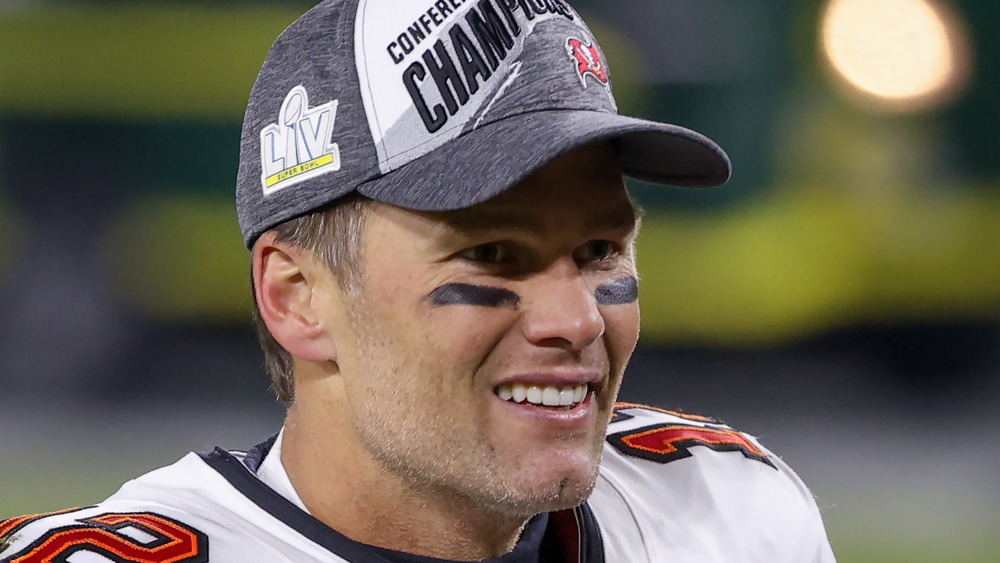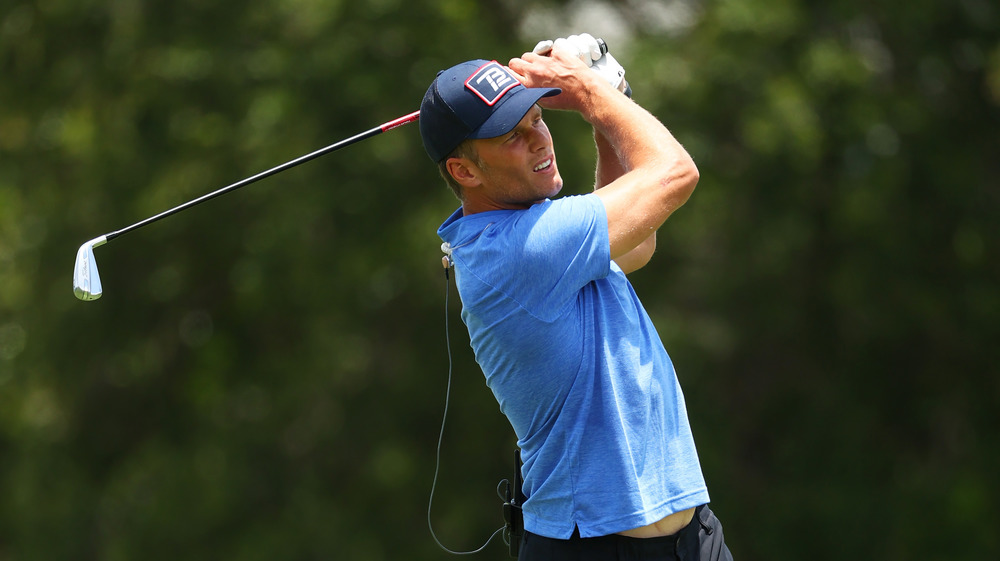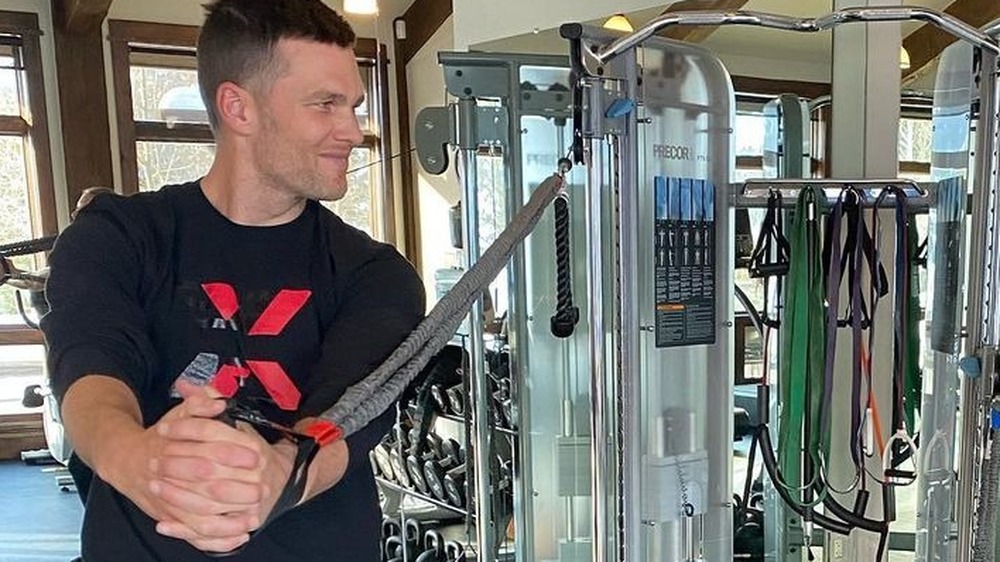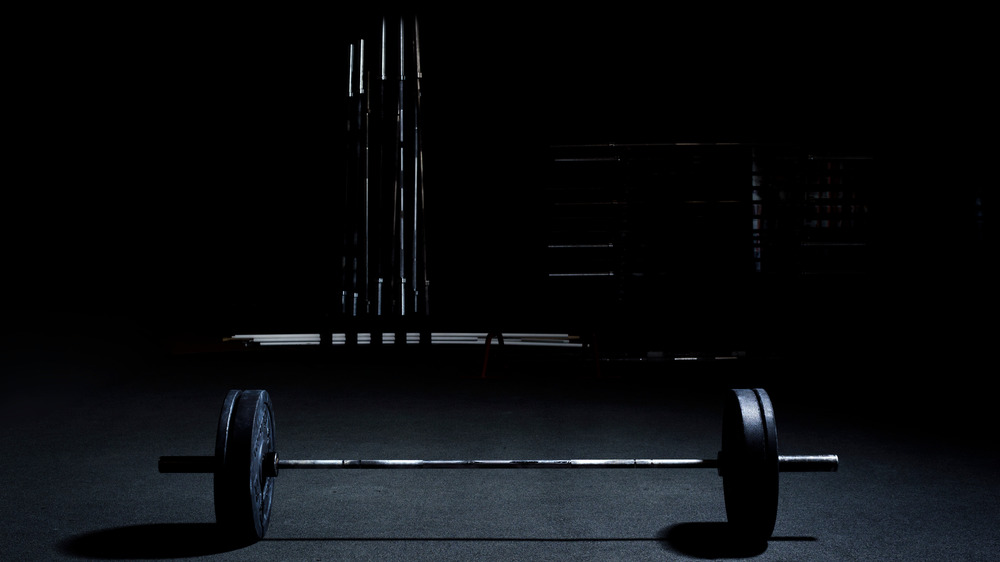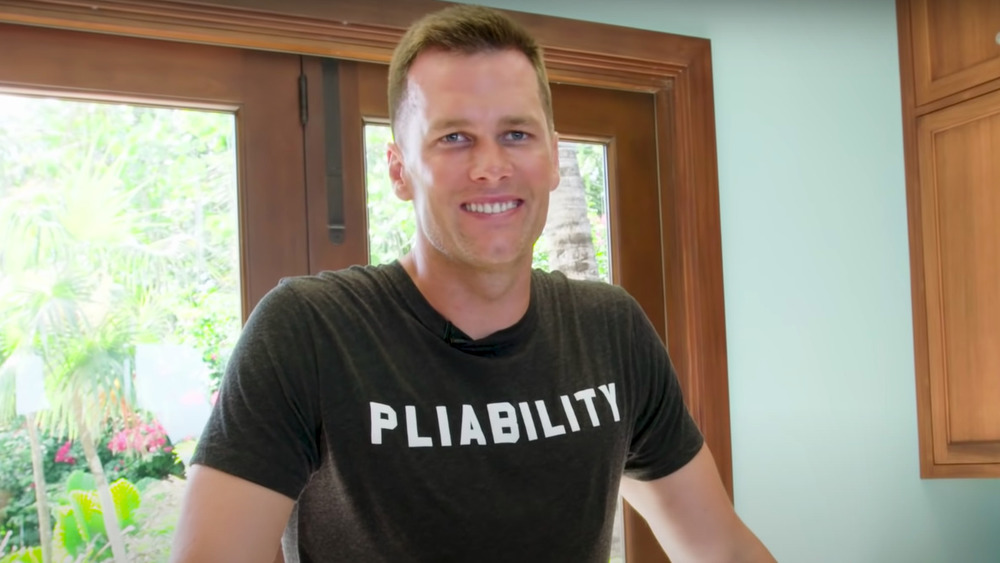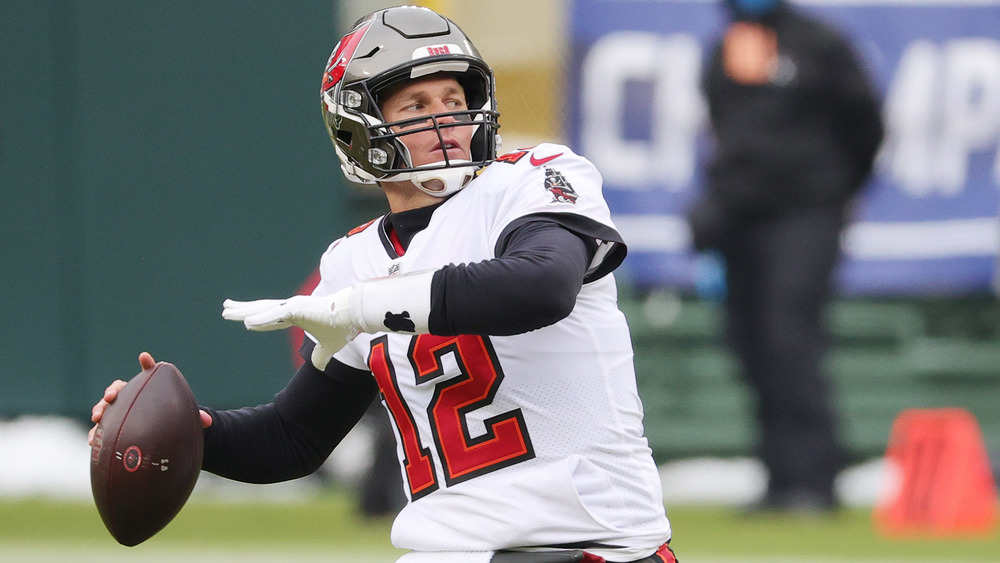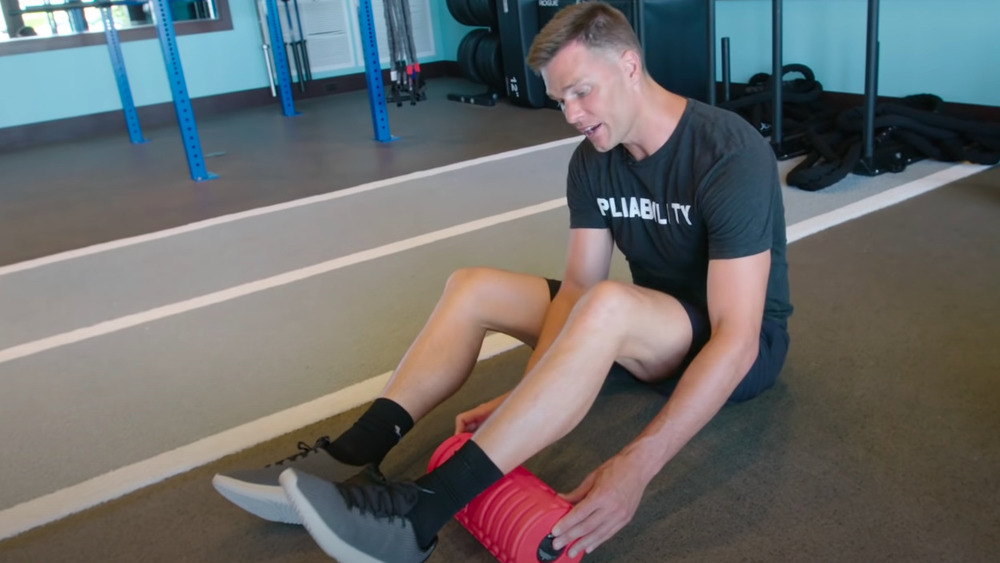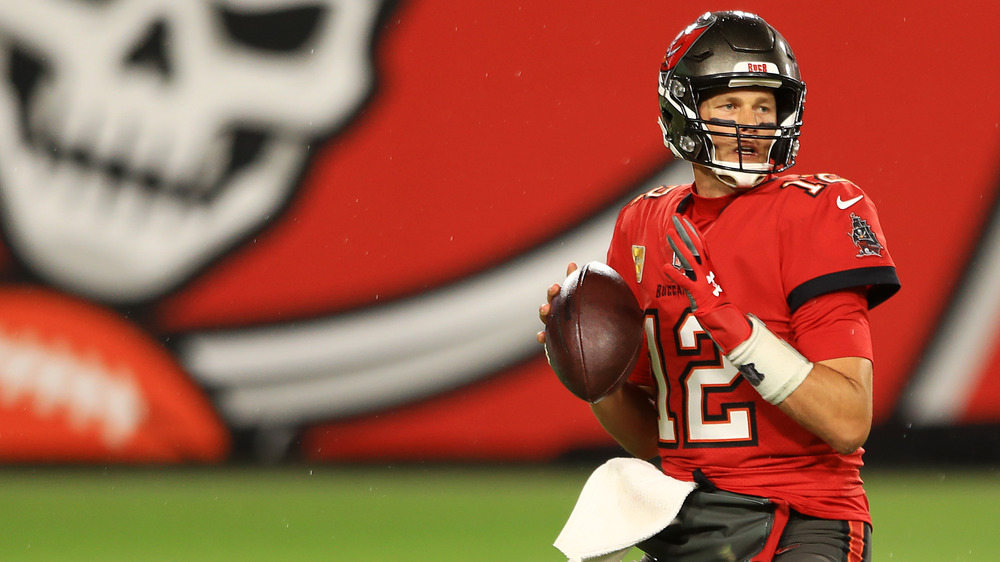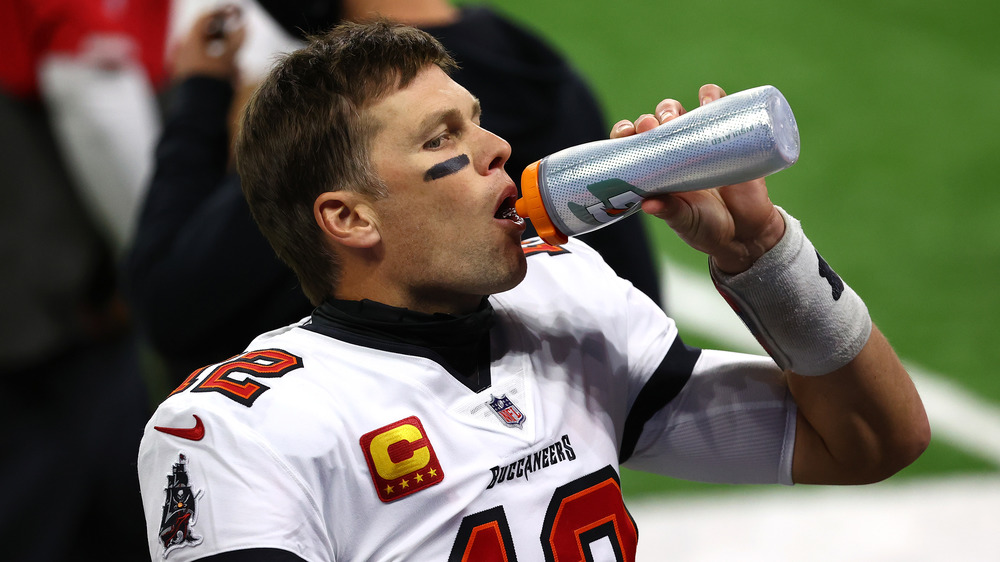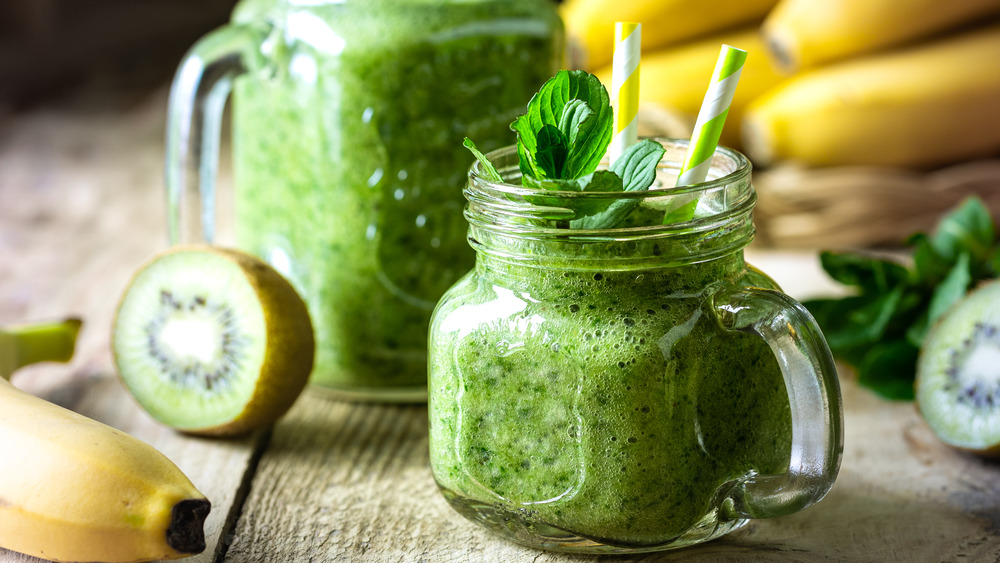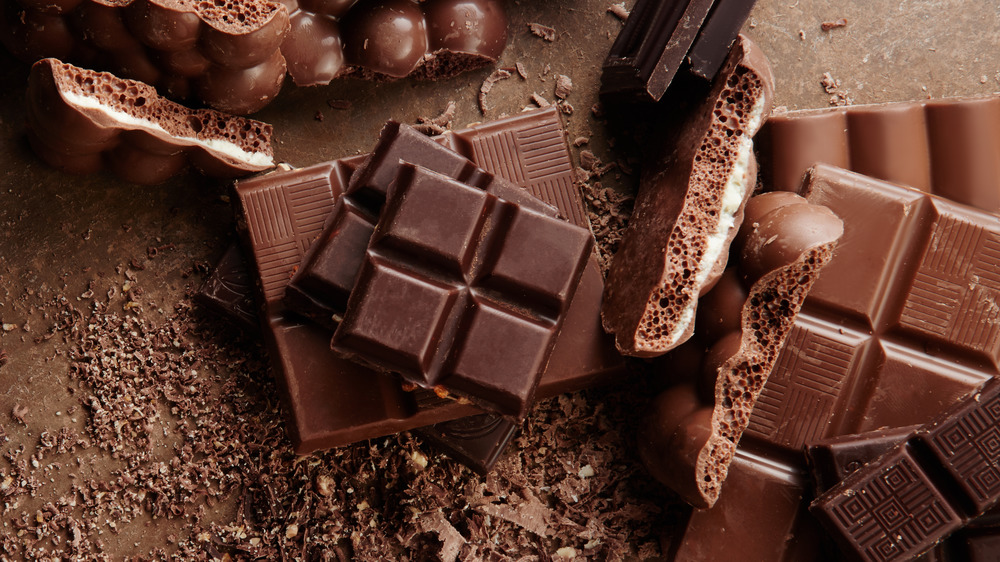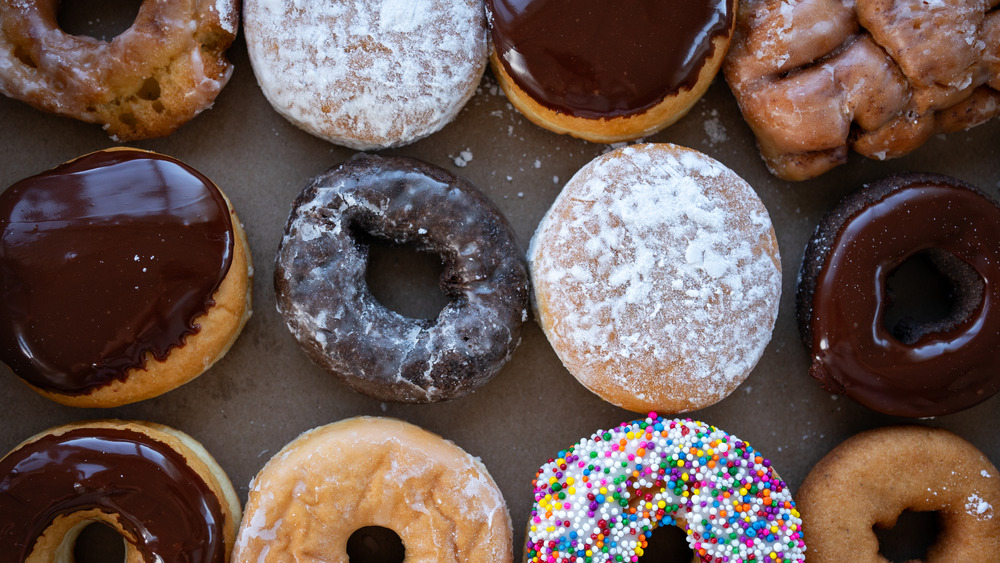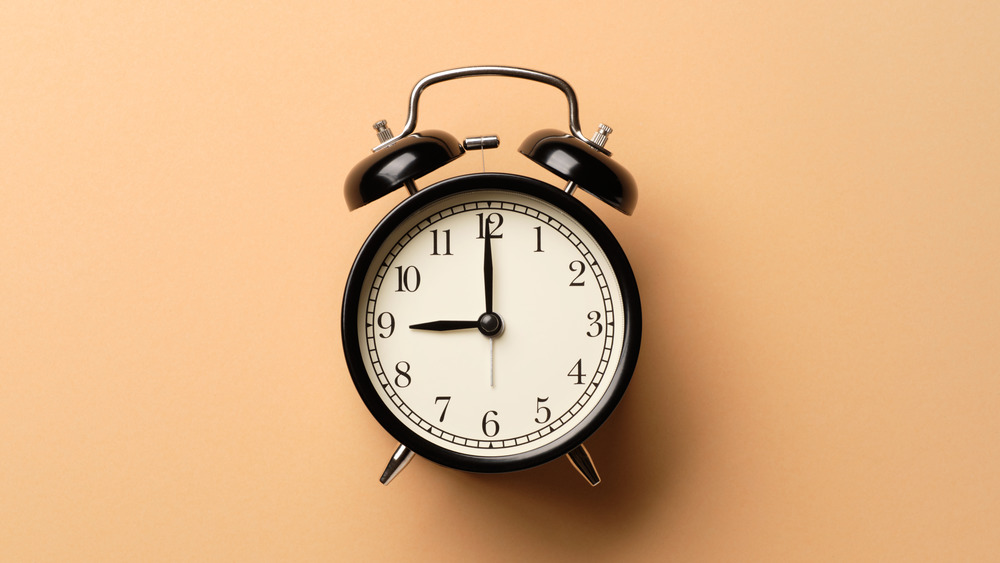Tom Brady's Intense Routine That Keeps Him So Fit
Tom Brady has been given the nickname the GOAT (greatest of all time) when it comes to quarterbacks. This seems fitting since he is the only player to appear in 10 NFL championships/Super Bowls, as Sports Illustrated reported. After his 2019 Super Bowl win with the New England Patriots, Tom Brady sat down with Michael Strahan for Good Morning America and commented on his nickname. "I don't even like it — it makes me cringe," Brady said (via CBS Sports). "I guess I take compliments worse than — I wish you would say, 'You're trash, you're too old, you're too slow, you can't get it done no more,' and I'll say, 'Thank you very much, I'm gonna go prove you wrong.'"
Other than defying people's expectations, what really keeps him going and successful is his health and wellness regimen that he's been following with trainer Alex Guerrero since 2006. "I absolutely know 100 percent that it works, and the reality is I'm just a client who lives by the teachings," Brady told Men's Health. Here's what you need to know about the intense routine followed by the Tampa Bay Buccaneers' star quarterback.
Tom Brady's daily routine is well established
According to TB12, a company co-founded by Tom Brady, the success the quarterback has seen over the past two decades is because he stays consistent. His daily routine is established — and he is very strict with his approach in order to continue to perform and recover.
His day starts off at 6 a.m. with 20 ounces of water that he infuses with electrolytes from TB12 (he apparently prefers the lemon flavor). A half-hour later, he takes a daily supplement followed by a smoothie loaded with whey protein, seeds, and nuts. Next on the schedule is his pre-workout pliability session (more on that later), followed up by a two-hour strength and conditioning workout, and ending with another pliability session.
As afternoon approaches, he studies film and prepares a lunch that normally consists of fish and plenty of veggies. Practice with his team starts at 3 p.m. and lasts until 5 p.m., and surprise, he performs another pliability session afterward. For dinner, Tom makes sure he has a "nutrient-dense" meal — complete with more vegetables. He finally starts to wind down and recover at around 8 p.m., and then hits the hay by 9 p.m.
Offseason doesn't slow Tom Brady down
Once football season ends, Tom Brady keeps up his workout routine to prep for the next season. "As you get older, [the game] becomes a little more challenging," Brady told Men's Journal. "So in the offseason, I do, I try to do a lot of the things I do in the season."
So what exactly does the quarterback's offseason routine look like? In an interview with Bodybuilding, Brady said, "In the off-season I still do cardio six days per week 40 to 60 minutes per day, but I do more running than in-season." He went on to add, "In the off-season I also switch my weight lifting over to a routine more so orientated toward strength and my sessions are usually about 25% longer since my body isn't beat up from playing."
Brady is devoted to his job, of course, and continuing to train throughout the year is important. In his interview with Men's Journal, Brady said, "It's been a lot of fun to commit in the offseason to the same things I'm doing in the season, in order to maintain a high level of play."
During football season, Tom Brady sticks to a nine-exercise workout
Brady's longtime body coach and TB12 co-founder, Alex Guerrero, told TB12 that Tom Brady relies on a nine-exercise workout that he does throughout football season. It goes hand in hand with offseason conditioning and helps to increase the speed of recovery. The main tool needed for these workouts: resistance bands.
To start, Brady does a quick warmup to get his blood flowing and stimulate his nervous system. From there he goes into the following nine moves using resistance bands: standing row, banded pushup, banded core rotations, deadlift, bicep curl, banded tricep extension, deceleration lunges, banded shoulder press, and X-band squat.
With these various moves, Brady is able to hit multiple muscle groups and get a full-body workout. Although you may not be ready to dive into Brady's exact fitness routine, you may want to experiment with resistance bands. As TB12 stated, they're a great alternative to weights since you get all the benefits without the risk of overload.
Tom Brady doesn't count reps
A great workout routine is no good unless you're ensuring that your form is correct. "At TB12, we emphasize the importance of proper form during workouts," Tom Brady told the company. "You should always start in a biomechanically neutral position — knees over feet, hips over knees, shoulders over hips, a firm core — because if you're not in proper alignment, you're conditioning your body to be out of balance."
Oftentimes when working out, people aim to reach a certain number of sets and reps for each move. Instead of setting a specific number to complete, Brady continues the move until muscle exhaustion. That is the point when form typically starts to waver and it's important to stop. "Other muscles are compensating for the muscle that should be working, and unless I stop, my brain will learn a new behavior — in this case, a negative one," he went on. "Athletes often say, 'I did ten reps!' But what if after the fourth or fifth rep, their form begins breaking down?" Above all else, Brady said you need focus on your form.
Tom Brady used to lift heavy, but wound up injured
Tom Brady didn't always utilize resistance bands to complete his workouts, in fact, he used to lift weights often. "You gotta understand, I was like every other American kid," he said in an interview with Men's Health. "I believed if you want to get good, you gotta go squat and bench, and it's all I ever did."
Unfortunately, that routine landed him in trouble. He ended up with severe tendinitis due to lifting heavy weights mixed with constant football throwing. It started to get so bad that in 2006, his quarterback rating started to drop, and he needed to take days off from practice.
Weightlifting injuries aren't necessarily unusual. A review published in the British Journal of Sports Medicine set out to determine the prevalence and incidence of injuries in both powerlifting and weightlifting. In the end, the journal found that the most common injury locations included the spine, shoulder, and knee. In terms of incidence, for every 1,000 hours of weightlifting training, there were typically between two to three injuries.
Tom Brady essentially lives by one word: pliability
While he was dealing with his elbow injury, Tom Brady started to get desperate for help. That's when he was referred to his current coach, Alex Guerrero. Brady told Men's Health in an interview that Guerrero felt the inflamed tendon in his elbow and "said that what we're going to do through pliability — although we didn't even call it pliability then, because we had to come up with a word for it — is effectively lengthen the forearm muscle and lengthen the biceps and triceps through deep-force work." Brady continued, saying, "Alex did it one time and I was like, 'What? The last ten years of my life I've been in pain, and now, after he's worked on my forearms, biceps and triceps, there's no more pain in my elbow?'"
A blog post by TB12 explained the term "muscle pliability" as the "state in which your muscles are long, soft, and resilient." You don't need to be an NFL quarterback to benefit from muscle pliability. As Healthline explained, having both flexible and pliable muscles and tendons can help you in everyday, functional movements.
Tom Brady favors soft over dense muscles
Once Brady realized his new pliability routine was helping him thrive, he published a book, The TB12 Method: How to Achieve a Lifetime of Sustained Peak Performance, to share it with the world. An article published in The New York Times broke down the book and Brady's method, which is built on the trainer Alex Guerrero's theory that muscles need to be "pliable."
"Pliable muscles, which are not the same as flexible muscles, are 'soft' and not 'dense,'" the book review explained. "Dense, stiff muscles are easily injured, according to the book, because they are not resilient and can tear during physical activity. On the other hand, soft, pliable muscles absorb the stresses and impacts that occur during daily life and sports." Brady asserts in his book that some common workouts — like weight training and sprinting — can lead to "dense" muscles.
Tom Brady massages his muscles with a foam roller daily
Thanks to TB12 sharing Brady's daily routine, we've learned that the quarterback believes in the power of foam rollers. Every night, Tom Brady uses his TB12 Vibrating Pliability Roller and the TB12 Vibrating Pliability Sphere. According to the company, Brady will do this for about 20 to 30 seconds to treat sore or tight muscles.
This strategy of foam rolling has quite a bit of science to help back it up. One study published in the Journal of Athletic Training tasked participants with performing 10 sets of 10 back squat repetitions "at 60% of their 1-repetition maximum, followed by either no foam rolling or 20 minutes of foam rolling immediately, 24, and 48 hours postexercise." The group that did 20 minutes of foam rolling immediately after exercise and every 24 hours thereafter experienced a "moderate to large" reduction in muscle tenderness, which prevented a decline in physical performance.
Another study, this one published in the International Journal of Sports Physical Therapy, found that when foam rolling was combined with static stretching in resistance-trained athletes, it helped improve joint range of motion by about 9 percent compared to 6 percent with only stretching.
Tom Brady listens to U2 to get fired up for a workout
Your workout is only as good as the music you choose to listen to, right? In an interview with Men's Health, Tom Brady was asked to name the music that gets him "fired up" for his workout. His response: "A lot of U2." When the interviewer asked him what his favorite track is, he states, "Uh, there's a lot of them." He even sang a bit of one of the band's hits, "Sunday Bloody Sunday."
Even if U2 isn't for you, listening to music can delay fatigue and increase exercise performance, endurance, power, and strength. A study published in the International Journal of Physiology, Pathophysiology and Pharmacology put that to the test and evaluated the effect of music on exercise performance in young, untrained subjects. Groups were split up to do submaximal exercise with or without music. The results revealed that the exercise duration in the music group clocked in at an average of 37 minutes. This was significantly greater than the non-music group, which ended up with an average of about 22 minutes.
Tom Brady drinks a lot of water
Hydration is a key component to health, which should come as no surprise considering our bodies are about 60 percent water (via USGS). Tom Brady isn't slacking on how much water he drinks either — especially since leaving New England and practicing and playing in the Tampa Bay heat. According to Men's Health, Brady typically drinks anywhere from 12 to 25 glasses of water each day. Even his morning starts with 20 ounces of water paired with his favorite electrolytes (via TB12).
Now, this doesn't mean you should also be drinking 25 glasses of water each day. After all, it's possible to drink too much water. Dr. Julian Seifter, a kidney specialist and associate professor of medicine at Harvard Medical School, told Harvard Health that water intake varies from person to person.
A general rule of thumb for healthy people is to aim for a daily intake of 4 to 6 cups. If you're not drinking enough, you'll notice symptoms of dehydration such as weakness, low blood pressure, dizziness, confusion, or dark urine.
Tom Brady's diet used to be very strict, but he's since become a little more relaxed
Tom Brady has a generally healthy diet, but it used to be much more stringent. In his 2017 book, Brady talked about eating "alkalizing" foods meant to decrease inflammation in the body (via Men's Health). He would avoid foods like tomatoes, peppers, mushrooms, caffeine, white flour, white sugar, and dairy (via Boston.com). Since then, though, he told Men's Health he's given himself a little bit more wiggle room. "I have a friend who freaks out if it's not the most organic this or that, and I'm like, 'That stress is going to harm you way more than eating that chip is,'" Brady revealed.
Still, Brady does continue to eat many of the same foods. According to Men's Health, he enjoys "berry-and-banana smoothies pre-workout; avocado and eggs for breakfast; salads with nuts and fish for lunch; hummus, guacamole, or mixed nuts for snacks; and roasted vegetables and chicken for dinner."
These are the foods Tom Brady always keeps in his fridge
Want your refrigerator to look like Tom Brady's? Make room, because in an interview with Men's Health, Brady said his fridge includes "a lot of vegetables, a lot of fruit, and always chocolate."
The typical candy bar made of milk chocolate and lots of sugar isn't going to benefit your health, but dark chocolate may. According to the Journal of Pharmacognosy and Phytochemistry, dark chocolate that is minimally processed from cocoa beans is high in flavonoids, which boost antioxidant activity. This activity can reduce risk of diabetes and may benefit cardiovascular related disorders. The Nutrition Source recommends getting 70 percent dark chocolate or higher in order to get the most flavonoids. Be warned though, this isn't your typical sweet candy bar. The higher the percentage of cocoa solids, the more bitter the chocolate is.
Although Brady always has chocolate on hand, you'll never catch him eating chocolate-covered strawberries. The quarterback told Men's Health that strawberries are the one food he never has in his fridge. When asked what he doesn't like about them, he responded with, "Color, smell, taste, look."
Tom Brady believes in moderation and balance in all things
Tom Brady is down for allowing himself any kind of food, but he makes sure it's worth it. "If I'm craving bacon, I have a piece. Same with pizza. You should never restrict what you really want. We're humans, here for one life," Brady told Men's Health. "What's changed as I've gotten older is now if I want pizza, I want the best pizza. I don't eat a slice that tastes like s*** and then wonder, 'Why am I eating s*** pizza?'"
It can be challenging to completely avoid certain foods for long periods of time, which is often why diets only work temporarily. "We need to be more in tune with what works best for us, without feeling deprived, causing us to bounce back to prior unhealthy eating styles," Sharon Zarabi, registered dietitian, told Healthline.
Brady told CBS Boston that he believes in balance and moderation in all things. While he doesn't believe in saying "never" to certain foods, like donuts, he told the outlet, "I don't think you should eat five of them!"
Tom Brady prioritizes getting eight hours of sleep each night
Tom Brady's bedtime is at 9 p.m. because it's important to him to get a full eight hours of sleep each night, according to TB12. Before he hits the hay, he takes a supplement that contains dehydrated tart cherry skins, which provides melatonin. This helps him get a deep, restful sleep to be prepared for his next full day.
Getting enough sleep is important for mental and physical health, which is why it's a crucial part of Brady's routine. When you're not getting efficient sleep over time, you have a greater risk for chronic diseases, according to the National Heart, Blood, and Lung Institute. It also affects how you "think, react, work, learn, and get along with others."
Inadequate sleep has also been shown to impact physical performance in terms of exercise. A review published in the Journal of Science and Medicine in Sport found that sleep deprivation impaired maximal muscle strength in participants. No wonder Brady values his shut-eye.

